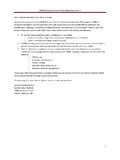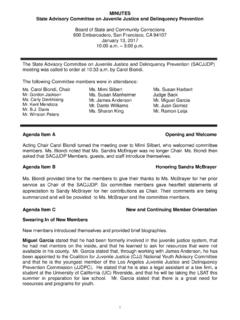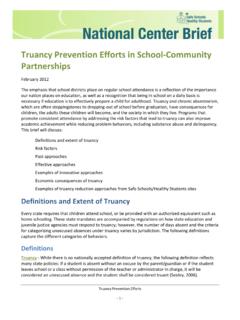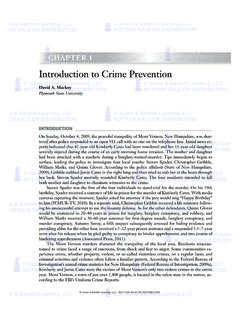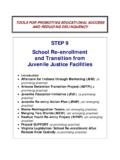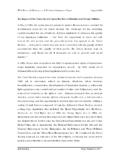Transcription of Take Care to Do No Harm: Harmful Interventions for Youth ...
1 Take Care to Do No harm : Harmful Interventions for YouthProblem BehaviorDana M. RhuleUniversity of WashingtonYouth conduct problems, delinquency , and substance abuse pose serious consequences for the youththemselves, their victims and families, and the broader society. The widespread impact of these problembehaviors highlights the importance of preventing and treating them effectively. Despite this need, anemerging literature has demonstrated that certain intervention programs for these problem behaviors,particularly those that have used group-delivery formats, have produced iatrogenic effects. The potentialfor intervention to produce negative outcomes raises several ethical implications and dilemmas.
2 In thisarticle, the author provides illustrative examples of iatrogenic effects of Interventions that target youthconduct problems, delinquency , and substance abuse; discusses the relevant ethical implications raised bythese outcomes; and suggests recommendations to prevent, detect, and respond to their :iatrogenic effects, Youth Interventions , Youth problem behavior , Harmful interventionsYouth conduct problems, delinquency , and substance abuse areserious problems that warrant societal attention. Each may beconceptualized as a form of problem behavior (Jessor & Jessor,1977) that is associated with negative outcomes for the Youth andfor society.
3 Unfortunately, these problem behaviors occur atalarmingly high rates in Youth . Conduct problems are among themost commonly occurring child behavior disorders, with preva-lence rates for conduct disorder ranging from 6% 16% for boysand 2% 9% for girls (American Psychiatric Association, 2000).The 2003 National Survey on Drug Use and Health (SubstanceAbuse and Mental Health Services Administration [SAMHSA],2004) indicated that the rate of substance abuse or dependence for Youth ages 12 17. According to self-report, 30% of highschool seniors in the United States engaged in minor criminalactivity, 12% 15% engaged in serious fighting or assault, and9% 14% were involved in major theft or property damage in thepast year (Johnston, Bachman, & O Malley, 1997).
4 In terms ofsubstance use, 39% of high school seniors had used illicit drugs,70% had consumed alcohol, and 48% had been drunk in the pastyear (Johnston, O Malley, Bachman, & Schulenberg, 2004). problem behavior poses serious personal and economic costsfor Youth s victims and families, as well as for problems and substance abuse have been associatedwith widespread deficits and maladjustment in numerous do-mains including social and romantic relationships, educationaland occupational attainment, and physical and mental health(Essau, 2003; SAMHSA, 2004). Cohen (1998) has estimated ex-ternal costs as high as $ $ million for the typical careercriminal and $370,000 $970,000 for a heavy drug user.
5 Clearly,the widespread impact of these problem behaviors underscoresboth the importance of preventing and treating them effectivelyand the high personal and societal cost of failing to do so. How-ever, despite the need for adequate Interventions , many treatmentshave not demonstrated impressive success, and several have inad-vertently produced increases in problem emerging literature has demonstrated that certain preventionand treatment programs for Youth problem behavior , particularlythose that have used group-delivery formats, have produced iatro-genic effects. Some studies have documented increases in exter-nalizing behaviors, delinquency , alcohol and drug use, and otherundesirable outcomes, which may have resulted from the exposureto deviant peers afforded by these Interventions .
6 It is important tonote that these Interventions were not reckless in their develop-ment or implementation. Rather, they were developed with theworthy intentions of serving Youth and reducing problem , these programs did not fulfill their anticipated objectivesand instead unintentionally promoted the very behaviors they wereattempting to possibility for prevention and treatment programs to pro-duce negative effects poses several ethical implications and dilem-mas, which I highlight in this article. The Ethical Principles ofPsychologists and Code of Conduct (American Psychological As-sociation, 2002; herein referred to asthe ethics code) refers toaspirations of beneficence and nonmaleficence, which are threat-ened by the potential or actual occurrence of harm resulting frominterventions.
7 With these aspirational goals in mind, the interven-tion community must consider what ability it has to foresee iatro-genic effects and what appropriate steps should be taken to preventand respond to such outcomes. In this article, I explore the iatro-genic effects of several prevention and treatment programs forchildren and adolescents that target conduct problems, juveniledelinquency, and substance abuse, and the ethical implicationsDANAM. RHULE received her MS in psychology from the University ofWashington. She is currently a doctoral graduate student in child clinicalpsychology. Her research interests include the development, intergenera-tional transmission, prevention, and treatment of problem McMahon and Corey Fagan for their contributions toearlier versions of this be addressed to DanaM.
8 Rhule, University of Washington, Department of Psychology, Box351525, Seattle, WA 98195-1525. E-mail: Psychology: Research and PracticeCopyright 2005 by the American Psychological Association2005, Vol. 36, No. 6, 618 6250735-7028/05/$ DOI: by these outcomes. My goal in this article is to address theseissues by providing several illustrative examples of iatrogeniceffects of Interventions and suggesting recommendations to pre-vent, detect, and respond to their and Treatment Programs for problem BehaviorOver the past few decades, the field of prevention science hasemerged and grown, partially in response to insufficient treatmentefficacy for Youth engaging in conduct problems, delinquency , andsubstance abuse.
9 Prevention programs aim to prevent problemsbefore they occur or to diminish less severe forms of conductproblems before they progress to full-blown disorders or delin-quency. The nature and specific content of these programs vary,but certain components are common, such as parent-traininggroups, case management and home visits, classroom curricula,teacher management strategies, and child social, problem -solving,or cognitive-skills training groups. Treatments for children andadolescents who are already demonstrating significant behaviorproblems use several of these same components but have also usedgroup residential care and individual , several programs have demonstrated efficacy in pre-venting and/or reducing delinquency , substance abuse, and con-duct problems.
10 These include parent training ( , McMahon &Forehand, 2003; Patterson, 1975; Webster-Stratton, 2000), cogni-tive skills training (Lochman, Burch, Curry, & Lampron, 1984),Functional Family Therapy (FFT; Alexander & Parsons, 1982),Multisystemic Therapy (MST; Henggeler, Schoenwald, Borduin,Rowland, & Cunningham, 1998), and Multidimensional TreatmentFoster Care (MTFC; Chamberlain, 1994), among others. Addition-ally, certain prevention programs have shown impressive successin reducing and preventing problem behavior , including the LifeSkills Training Program (Botvin & Kantor, 2000), the MontrealPrevention Experiment (Tremblay, Pagani-Kurtz, Masse, Vitaro,& Pihl, 1995), the Seattle Social Development Project (SSDP;Hawkins et al.)
